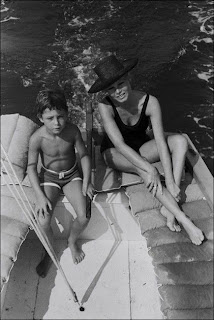Brigitte Bardot is one of the most iconic foreign actresses of all-time, possessing a puzzling combination of deep sultriness and doe-like innocence. One of the first foreign actresses to gain popularity in the US without making English-language films, the power of her impact is result of the naturalness of her talent and beauty.
Born in Paris France to a Roman Catholic family, Brigitte and her sister Marie-Jean were enrolled in dance classes at an early age. Although Marie-Jean stopped dancing to devote herself more seriously to academics, Brigitte devoted herself to the world of classical ballet, working towards a career as a dancer. In 1947 she was accepted to the Conservatoire de Paris, where she studied dance under the direction of Russian choreographer, Boris Knyazev for three years. One of her fellow students was Leslie Caron.
During her time at the Conservatoire, a friend of her mother’s asked Brigitte to model in a small fashion show. The fashion show lead her into various other modeling jobs, including a cover of Elle Magazine.
In the early 1950s, Bardot was working as a babysitter and was spotted by a young director, Roger Vadim. Vadim was shown the cover of Elle and immediately called film director Marc Allegret, asking him to call her in for an audition. Brigitte came in to audition for Allegret’s film and got the part, but the film never ended up being made. Nevertheless, the incident changed Bardot’s focus and she decided to pursue acting instead of dance.
Her debut performance as an actress was in 1952, in the film Crazy for Love. From 1952-1956, Bardot would appear in an astounding 17 films. She was typically cast in romantic comedies, or historical comedies, where she played an ingénue or vixen – usually only partially clothed. These roles, coupled with various seductive photo shoots, began to create a public persona for Bardot that established her as a siren.
In 1952, the same year she appeared in her first film and just after her 18th birthday, Bardot was married to Roger Vadim. Vadim was dissatisfied with the commercial films Bardot had chosen and encouraged her to participate in the New Wave movements of France and Italy. She took his advice, appearing in the film Vie Prive, for which she was nominated for a David di Donatello Award. She also appeared in Jean-Luc Godard’s critically acclaimed Contempt and And God Created Women.
After five years of marriage and an affair with actor Jean-Louis Trintignanat, Bardot and Vadim divorced. After their divorce, Bardot moved to Southern France. Two years after the divorce, she was re-married to Jacques Charrier, with whom she had a son, Nicolas-Jacques Charrier. Her marriage to Charrier also failed and subsequently, she married German millionaire, Gunter Sachs and later, Bernard d’Ormale. Later in life, she lived with sculptor Miroslav Brozek.
Bardot retired gracefully from acting in 1973, but continued recording music. Her most famous collaborations are with Serge Gainsbourg.
Bardot’s prolific career includes 47 films, 80 recorded songs, numerous musical productions, and a long-time devotion to animal rights. Her life was not without controversy – her extra-marital affairs were highly publicized and she was a major target for French paparazzi. She also received huge criticism for her staunch opposition to Islamic immigration to France, for which she has been accused of racism. But Bardot will always be remembered for the iconic images of her sweeping hair, gap tooth, and crooked smile. Her talent and beauty, as well as her impact in fashion have created a legacy not soon forgotten.










No comments:
Post a Comment